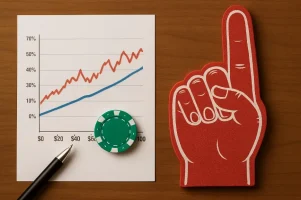Bias kills bankrolls. Using market data and line movement on mostbet helps you evaluate edges objectively, even when your favorite team is playing. Many bettors fall into the trap of wagering based on passion, loyalty, or gut feeling. While this can feel exciting, it rarely produces consistent returns. In contrast, value betting focuses on identifying mispriced odds and exploiting them for long-term profit.
The Trap of Emotional Betting
Supporting your favorite team is natural, but betting requires discipline. Emotional wagers ignore statistical evidence and overestimate the chances of personal favorites. This habit leads to inflated stakes, unnecessary risks, and long-term losses.
Signs You’re Betting With Emotion
- You consistently back your favorite team, regardless of odds.
- You increase stake size when your emotions are heightened (derbies, finals, rivalries).
- You avoid betting against your team, even if value clearly exists.
- You justify losses by blaming referees, luck, or injuries instead of poor analysis.
Recognizing these patterns is the first step toward rational wagering.
What Makes Value Betting Different
Value betting flips the focus. Instead of cheering for a team, the bettor asks: Are the odds fair? If the probability implied by the bookmaker is lower than your calculated probability, there’s value. Over time, consistently taking such edges leads to profit.
Example of Value Spotting
Suppose Team A is given odds of 2.50 (implied probability 40%). After analyzing form, injuries, and market data, you conclude their real chance is 50%. That 10% gap represents value. By repeatedly betting in these situations, variance smooths out and expected profit emerges.
Using Market Data and Line Movement
Sharp bettors monitor line movement—how odds change as money flows into the market. Sudden drops in odds usually signal that informed bettors are backing a side. Platforms like mostbet display this activity, helping players understand where the “smart money” is going.
Key indicators include:
- Opening vs. closing odds: A shift toward one side often reflects stronger consensus.
- Late moves: Drastic changes close to kickoff may indicate insider information.
- Volume spikes: Heavy action on one outcome suggests the market sees hidden value.
Balancing Objectivity and Passion
Fans don’t need to stop supporting their teams—but they must separate fandom from wagering. Some professionals even set a rule never to bet on clubs they support, avoiding subconscious bias altogether.
Practical Tips to Stay Objective
- Keep a record of all bets and review them monthly.
- Use statistics platforms to check performance, not gut feeling.
- Limit stakes when betting involves personal favorites.
- Compare odds across multiple bookmakers before committing.
- Accept that skipping a game is better than forcing a bet.
Conclusion
Value betting is a discipline built on math, not passion. Fandom brings joy, but betting requires detachment. By analyzing odds, tracking line movement, and avoiding emotional traps, players shift from gambling for excitement to investing with purpose. The sooner bettors learn to separate data from emotion, the sooner their bankrolls stop bleeding and start growing.

